On the Design of Thermal-Aware Duty-Cycle MAC Protocol for IoT Healthcare
Abstract
1. Introduction
- We present a thermal-aware wake-up schedule mechanism with the aim of reducing thermal-increase as well as avoiding the creation of hotspot.
- We provide a traffic taxonomy considering the diverse QoS demands.
- We introduce a superframe structure and designate distinct transmission periods exploiting both contention based and contention free medium access for diverse traffic types aiming to reduce contention along with treating the traffic based on their QoS requirements. Additionally, small and big DATA are treated differently to achieve fair QoS provisioning.
- We introduce an Emergency Data Management scheme with an intent to deliver urgent traffic reliably and timely.
- We perform extensive simulations to evaluate the performance of ThMAC and prove its effectiveness.
2. Related Works
3. Preliminaries and Assumptions
3.1. System Model
3.2. Traffic Taxonomy
- Emergency (Em) traffic: The traffic of this category possesses stringent delay and reliability requirements, and thus to be reported urgently whenever a node senses some unusual variations in physiological parameters.
- Delay constrained (Dc) traffic: This traffic category requires being delivered with lower delay, although it allows packet losses to some extent, for instance, telemedicine video streaming application.
- Reliability constrained (Rc) traffic: The traffic belonging to this type has high reliability requirements but it can tolerate some delay. Respiration monitoring, pH-level monitoring etc. are some examples of reliability constrained traffic which can be processed offline, but packet losses may cause a drastic effect.
- Normal (Nr) traffic: This traffic category does not have a strict delay nor reliability constraints. Periodic vital sign monitoring applications generate normal traffic when the sensed value falls below some threshold level.
4. ThMAC Design
4.1. Modeling Thermal Rise
4.2. Superframe Structure
4.3. Thermal Aware Wake-Up Schedule
| Algorithm 1 Thermal aware wake-up schedule algorithm at every node |
| INPUT Node temperature for node |
| 1: loop |
| 2: At each communication period, |
| 3: if AND then |
| 4: |
| 5: else if AND then |
| 6: |
| 7: else |
| 8: |
| 9: end if |
| 10: end loop |
4.4. MAC Operations
4.4.1. Contention Access Period (CAP)
4.4.2. Polling Period
4.4.3. DL Period
4.4.4. CFP Period
4.4.5. Emergency Data Management
5. Performance Evaluation
5.1. Simulation Environment
5.2. Performance Metrics
5.3. Simulation Results
5.3.1. Impact of Constant Parameters
5.3.2. Thermal Performance
5.3.3. Latency Performance
5.3.4. Reliability Performance
5.3.5. Energy Performance
5.3.6. Impact of Big DATA
6. Conclusions
Author Contributions
Funding
Conflicts of Interest
References
- Warneke, B.; Pister, K. MEMS for distributed wireless sensor networks. In Proceedings of the 9th International Conference on Electronics, Circuits and Systems, Dubrovnik, Croatia, 15–18 September 2002; Volume 1, pp. 291–294. [Google Scholar]
- Islam, S.M.R.; Kwak, D.; Kabir, M.H.; Hossain, M.; Kwak, K. The Internet of Things for Health Care: A Comprehensive Survey. IEEE Access 2015, 3, 678–708. [Google Scholar] [CrossRef]
- Ghamari, M.; Janko, B.; Sherratt, R.S.; Harwin, W.; Piechockic, R.; Soltanpur, C. A survey on wireless body area networks for ehealthcare systems in residential environments. Sensors 2016, 16, 831. [Google Scholar] [CrossRef] [PubMed]
- Chakraborty, C.; Gupta, B.; Ghosh, S.K. A review on telemedicine-based WBAN framework for patient monitoring. Telemed. e-Health 2013, 19, 619–626. [Google Scholar] [CrossRef] [PubMed]
- Ullah, S.; Higgins, H.; Braem, B.; Latre, B.; Blondia, C.; Moerman, I.; Saleem, S.; Rahman, Z.; Kwak, K. A Comprehensive Survey of Wireless Body Area Networks. J. Med. Syst. 2012, 36, 1065–1094. [Google Scholar] [CrossRef] [PubMed]
- Lazzi, G. Thermal effects of bioimplants. IEEE Eng. Med. Biol. Mag. 2005, 24, 75–81. [Google Scholar] [CrossRef] [PubMed]
- Tang, Q.; Tummala, N.; Gupta, S.K.S.; Schwiebert, L. Communication scheduling to minimize thermal effects of implanted biosensor networks in homogeneous tissue. IEEE Trans. Biomed. Eng. 2005, 52, 1285–1294. [Google Scholar] [CrossRef] [PubMed]
- Tang, Q.; Tummala, N.; Gupta, S.; Schwiebert, L. TARA: Thermal-Aware Routing Algorithm for Implanted Sensor Networks. In Distributed Computing in Sensor Systems; Prasanna, V., Iyengar, S., Spirakis, P., Welsh, M., Eds.; Springer: Berlin/Heidelberg, Germnay, 2005; Volume 3560, pp. 206–217. [Google Scholar]
- Bashirullah, R. Wireless Implants. IEEE Microw. Mag. 2010, 11, S14–S23. [Google Scholar] [CrossRef]
- IEEE 802.15.6: Wireless Body Area Networks. IEEE Standard for Local and Metropolitan Area Networks. 2012. Available online: http://ieeexplore.ieee.org/document/6161600 (accessed on 12 June 2019).
- Yuan, D.; Zheng, G.; Ma, H.; Shang, J.; Li, J. An Adaptive MAC Protocol Based on IEEE802.15.6 for Wireless Body Area Networks. Wirel. Commun. Mob. Comput. 2019, 2019. [Google Scholar] [CrossRef]
- Liu, B.; Yan, Z.; Chen, C.W. MAC protocol in wireless body area networks for E-health: Challenges and a context-aware design. IEEE Wirel. Commun. 2013, 20, 64–72. [Google Scholar] [CrossRef]
- Rezvani, S.; Ali Ghorashi, S. A Novel WBAN MAC protocol with Improved Energy Consumption and Data Rate. KSII Trans. Internet Inf. Syst. 2012, 6. [Google Scholar] [CrossRef]
- Ullah, S.; Kwak, K.S. An ultra low-power and traffic-adaptive medium access control protocol for wireless body area network. J. Med. Syst. 2012, 36, 1021–1030. [Google Scholar] [CrossRef] [PubMed]
- Li, H.; Tan, J. Heartbeat-Driven Medium-Access Control for Body Sensor Networks. IEEE Trans. Inf. Technol. Biomed. 2010, 14, 44–51. [Google Scholar] [CrossRef] [PubMed]
- Lee, J.; Kim, S. Emergency-Prioritized Asymmetric Protocol for Improving QoS of Energy-Constraint Wearable Device in Wireless Body Area Networks. Appl. Sci. 2018, 8, 92. [Google Scholar] [CrossRef]
- Huq, M.A.; Dutkiewicz, E.; Fang, G.; Liu, R.P.; Vesilo, R. MEB MAC: Improved channel access scheme for medical emergency traffic in WBAN. In Proceedings of the 2012 International Symposium on Communications and Information Technologies (ISCIT), Gold Coast, Australia, 2–5 October 2012; pp. 371–376. [Google Scholar]
- Zhou, J.; Guo, A.; Xu, J.; Celler, B.; Su, S. A reliable medium access mechanism based on priorities for wireless body sensor networks. In Proceedings of the 2013 35th Annual International Conference of the IEEE Engineering in Medicine and Biology Society (EMBC), Osaka, Japan, 3–7 July 2013; pp. 1855–1858. [Google Scholar]
- Zhang, C.; Wang, Y.; Liang, Y.; Shu, M.; Chen, C. An energy-efficient MAC protocol for medical emergency monitoring body sensor networks. Sensors 2016, 16, 385. [Google Scholar] [CrossRef] [PubMed]
- Moulik, S.; Misra, S.; Chakraborty, C.; Obaidat, M.S. Prioritized payload tuning mechanism for wireless body area network-based healthcare systems. In Proceedings of the 2014 IEEE Global Communications Conference, Austin, TX, USA, 8–12 December 2014; pp. 2393–2398. [Google Scholar]
- Zhou, J.; Guo, A.; Nguyen, H.T.; Su, S. Intelligent management of multiple access schemes in wireless body area network. J. Netw. 2015, 10. [Google Scholar] [CrossRef]
- Li, C.; Li, H.B.; Kohno, R. Reservation-based dynamic TDMA protocol for medical body area networks. IEICE Trans. Commun. 2009, 92, 387–395. [Google Scholar] [CrossRef]
- Fang, G.; Dutkiewicz, E. BodyMAC: Energy efficient TDMA-based MAC protocol for wireless body area networks. In Proceedings of the 2009 9th International Symposium on Communications and Information Technology, Icheon, Korea, 28–30 September 2009; pp. 1455–1459. [Google Scholar]
- Krishnamurthy, A.G.; Jun, J.; Agrawal, D.P. Temperature Aware Probabilistic Sleep Cycle Management for Body Area Sensor Networks. In Proceedings of the 2014 IEEE 11th International Conference on Mobile Ad Hoc and Sensor Systems, Philadelphia, PA, USA, 28–30 October 2014; pp. 519–520. [Google Scholar]
- Salehi, S.A.; Razzaque, M.A.; Tomeo-Reyes, I.; Hussain, N. IEEE 802.15.6 standard in wireless body area networks from a healthcare point of view. In Proceedings of the 2016 22nd Asia-Pacific Conference on Communications (APCC), Yogyakarta, Indonesia, 25–27 August 2016; pp. 523–528. [Google Scholar]
- IEEE Standard for Information Technology-Local and Metropolitan Area Networks. 2006. Available online: https://standards.ieee.org/standard/802_15_4-2006.html (accessed on 10 June 2019).
- Sullivan, D.M. Electromagnetic Simulation Using the FDTD Method; IEEE Press: Piscataway, NJ, USA, 2000. [Google Scholar]
- Polastre, J.; Hill, J.; Culler, D. Versatile low power media access for wireless sensor networks. In Proceedings of the 2nd International Conference on Embedded Networked Sensor Systems, Baltimore, MD, USA, 3–5 November 2004; pp. 95–107. [Google Scholar]


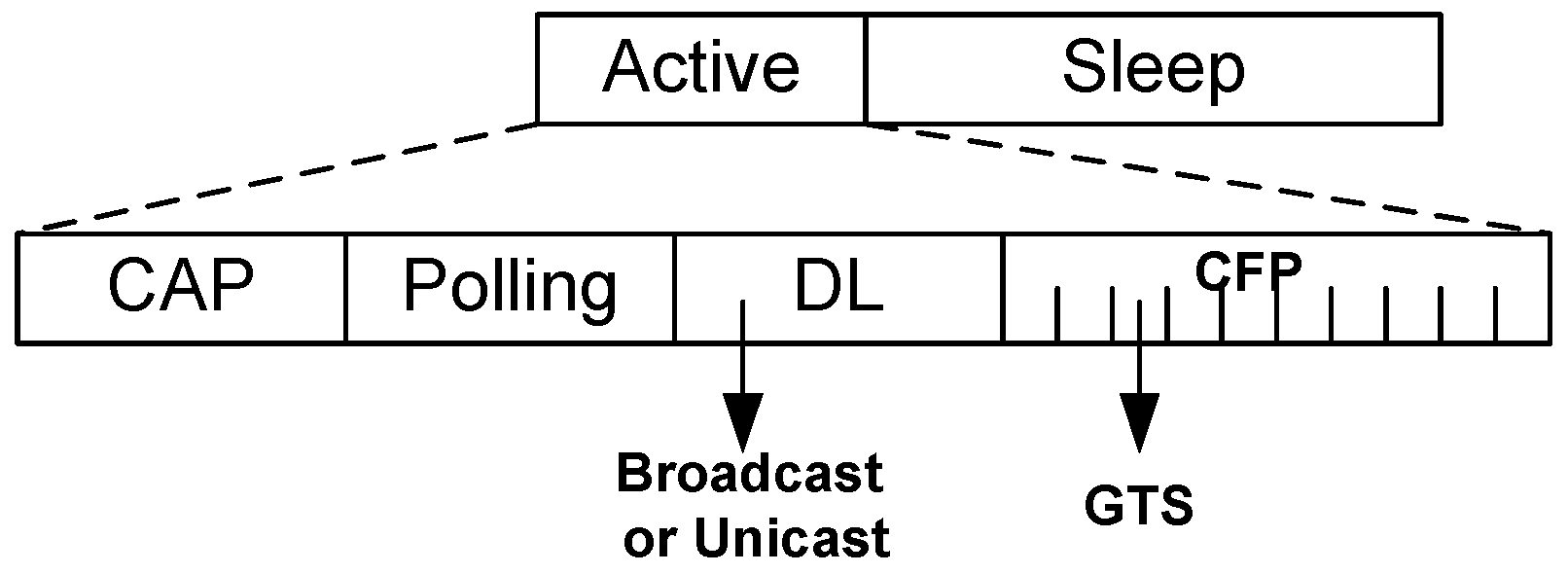
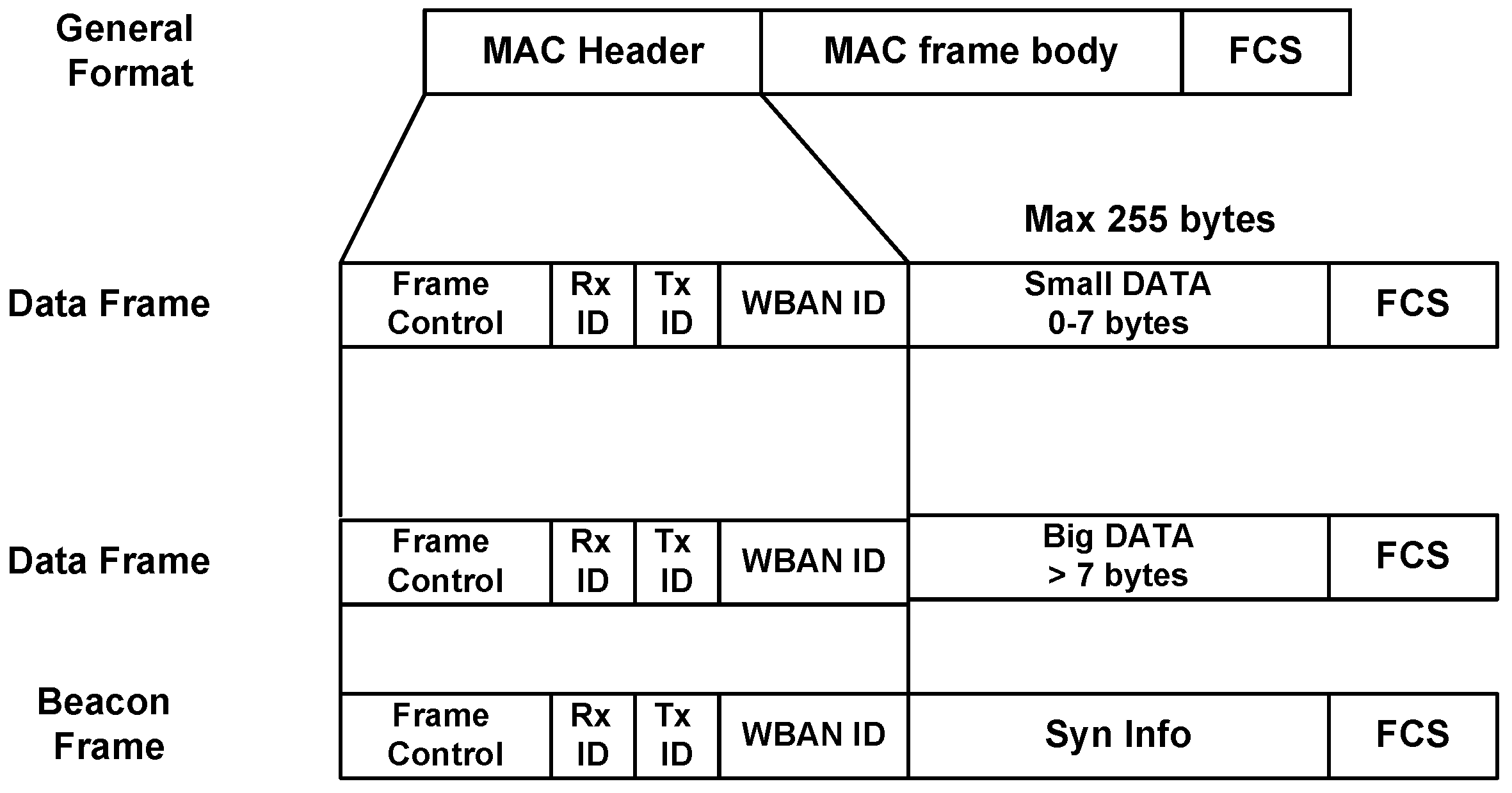
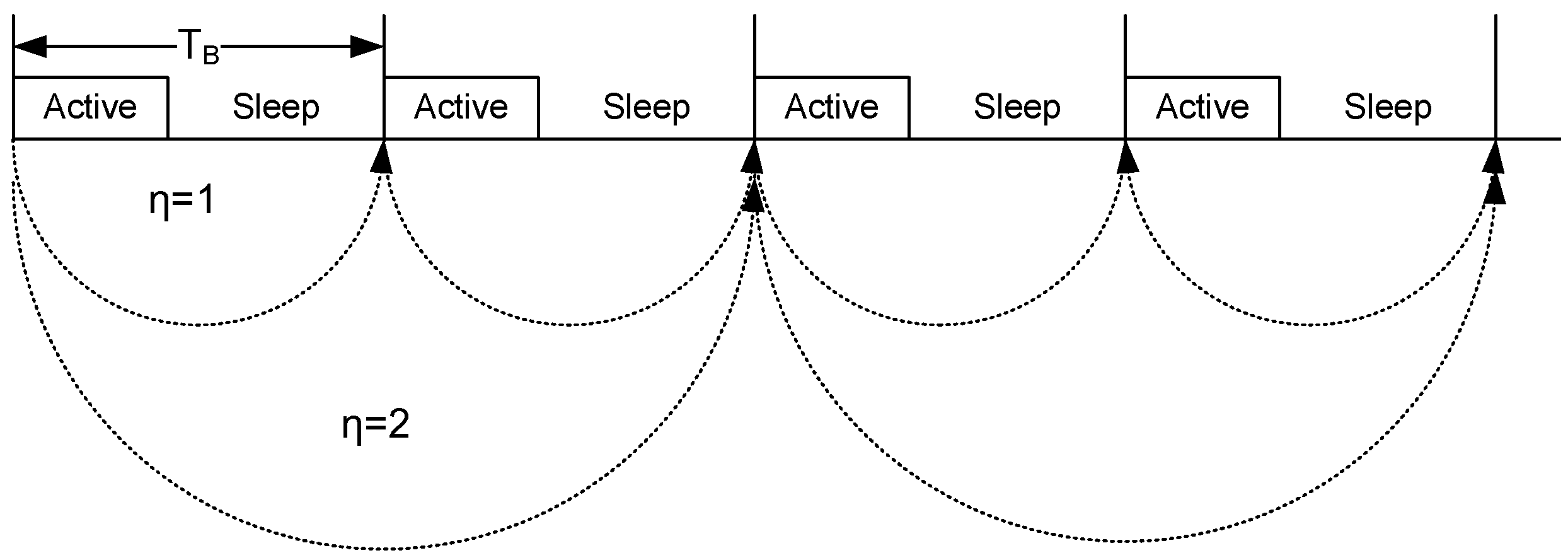
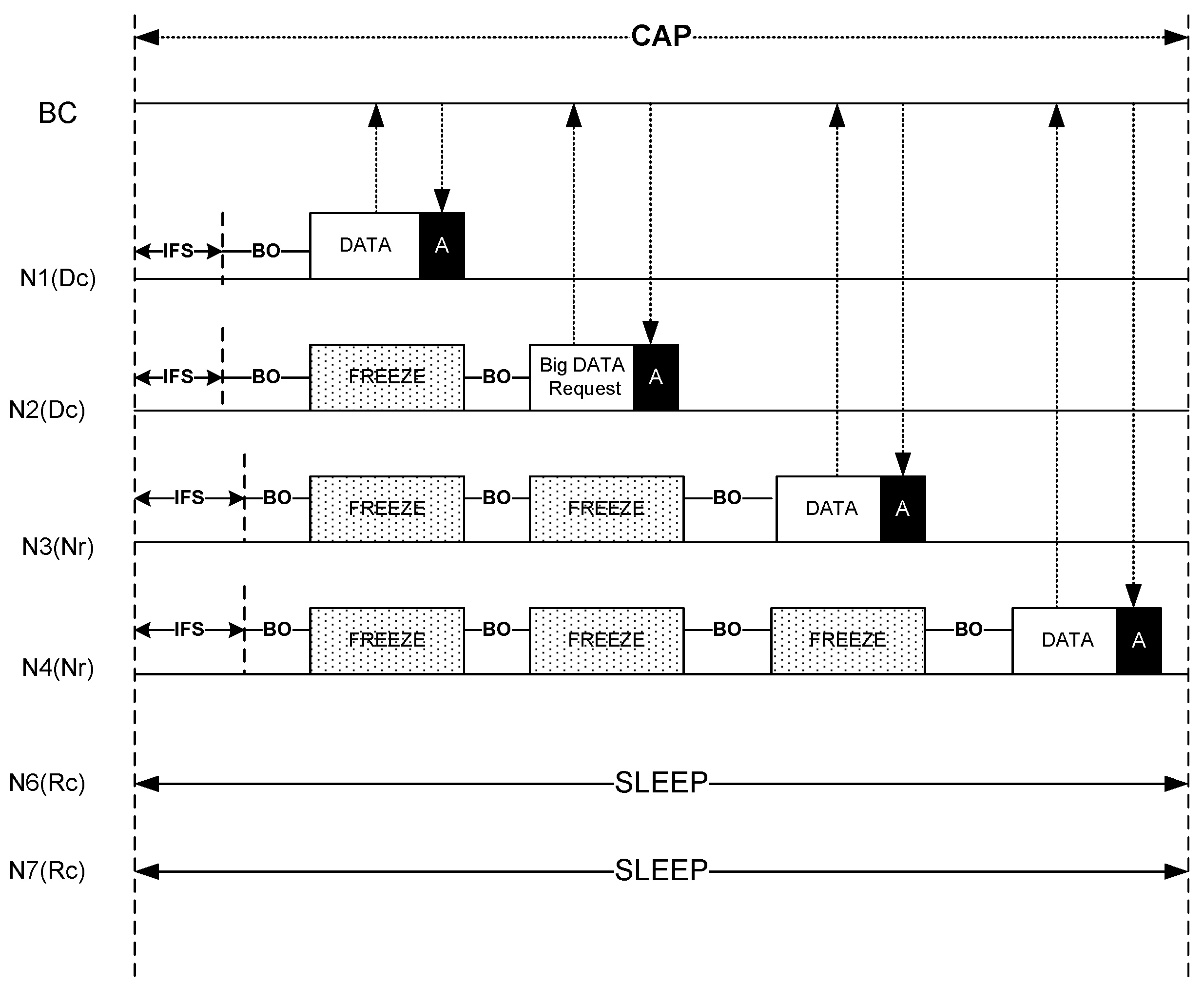
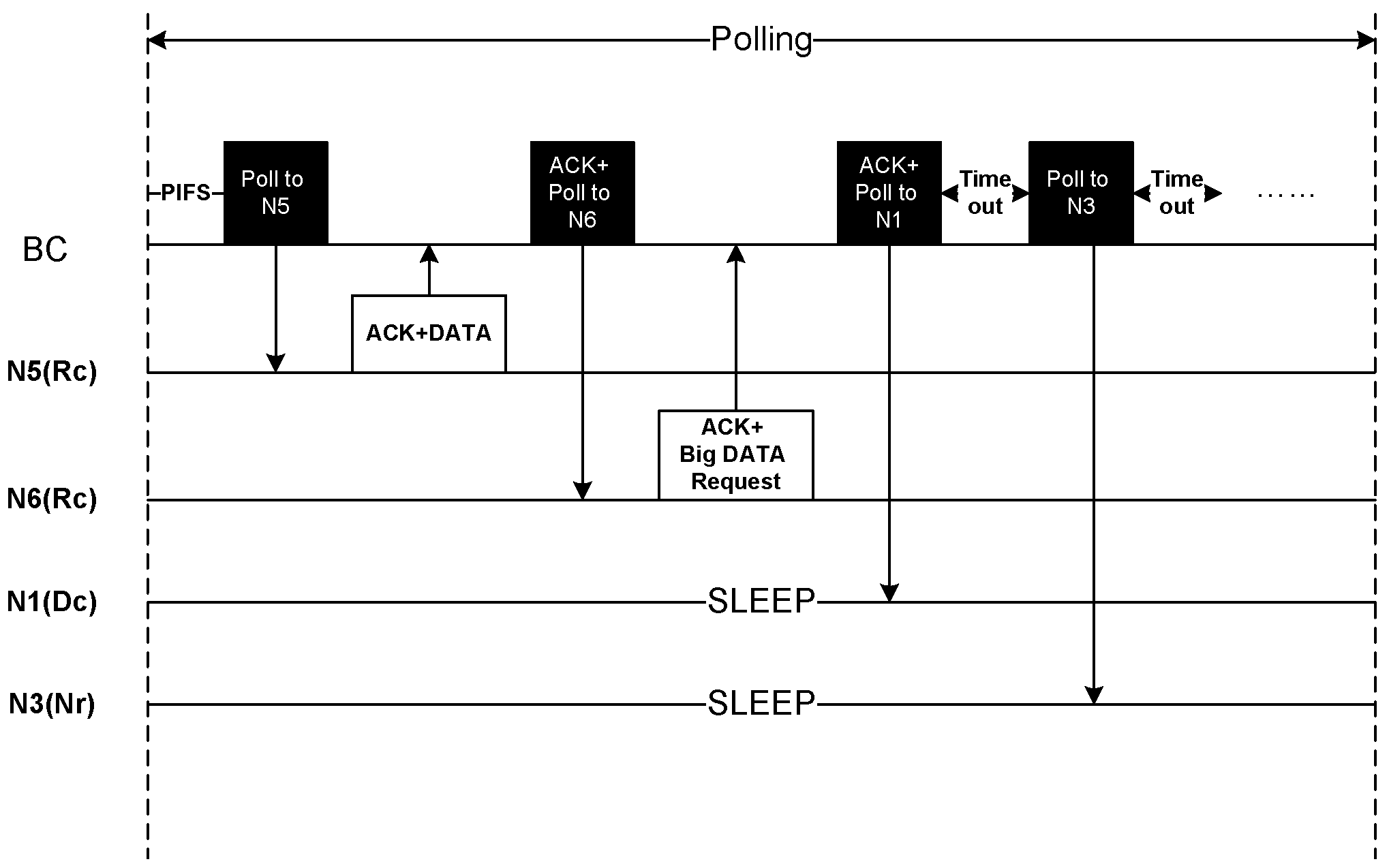
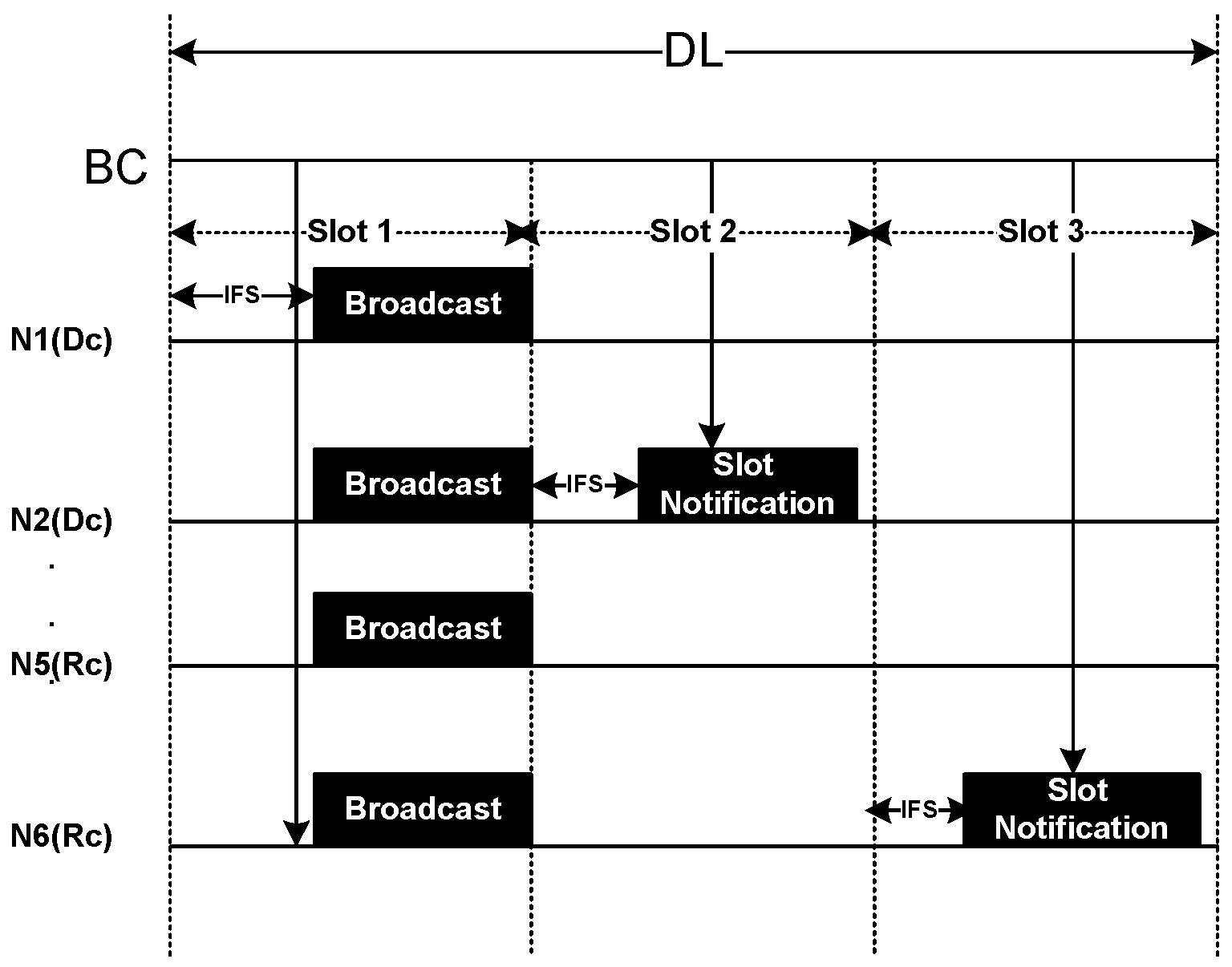
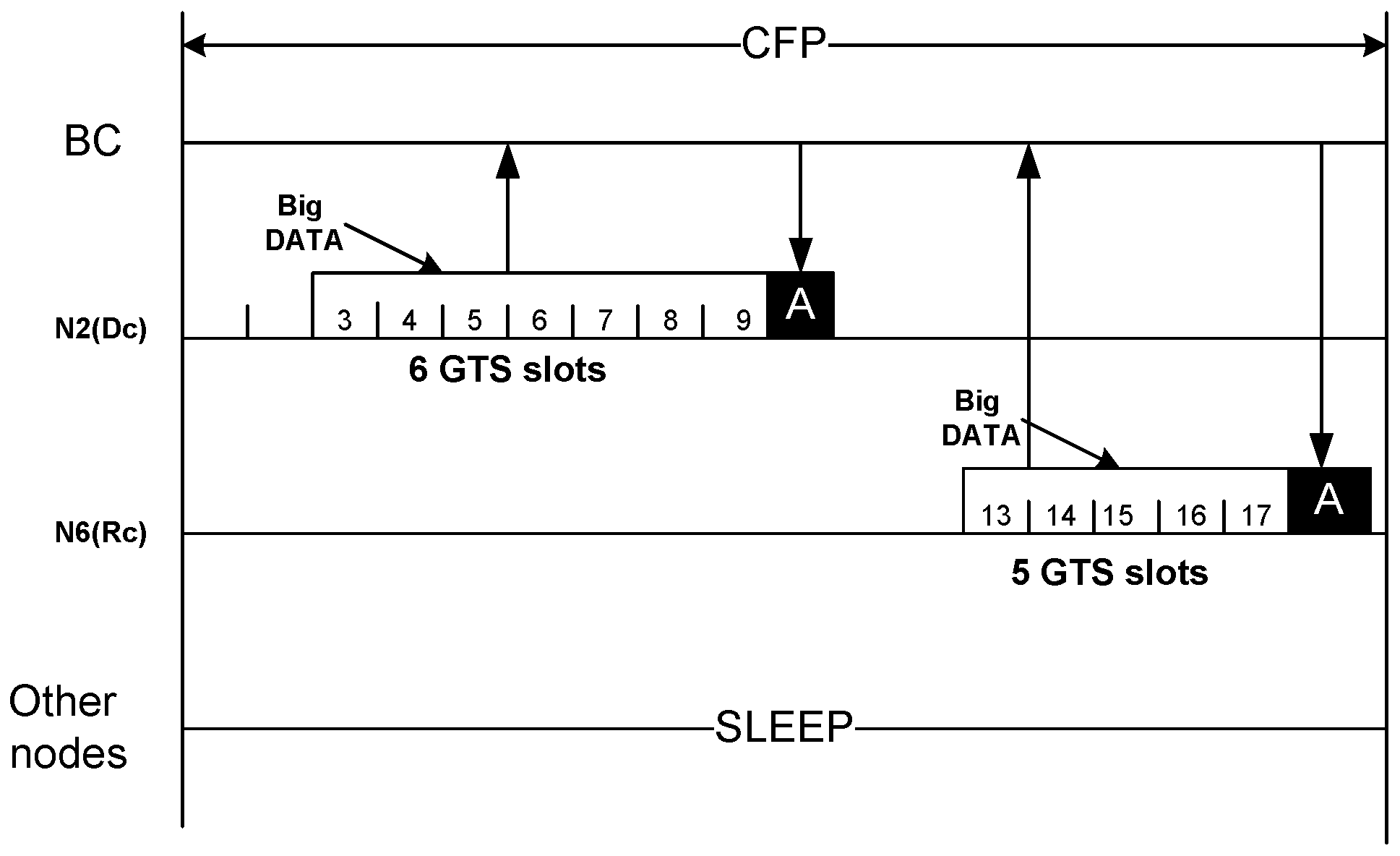
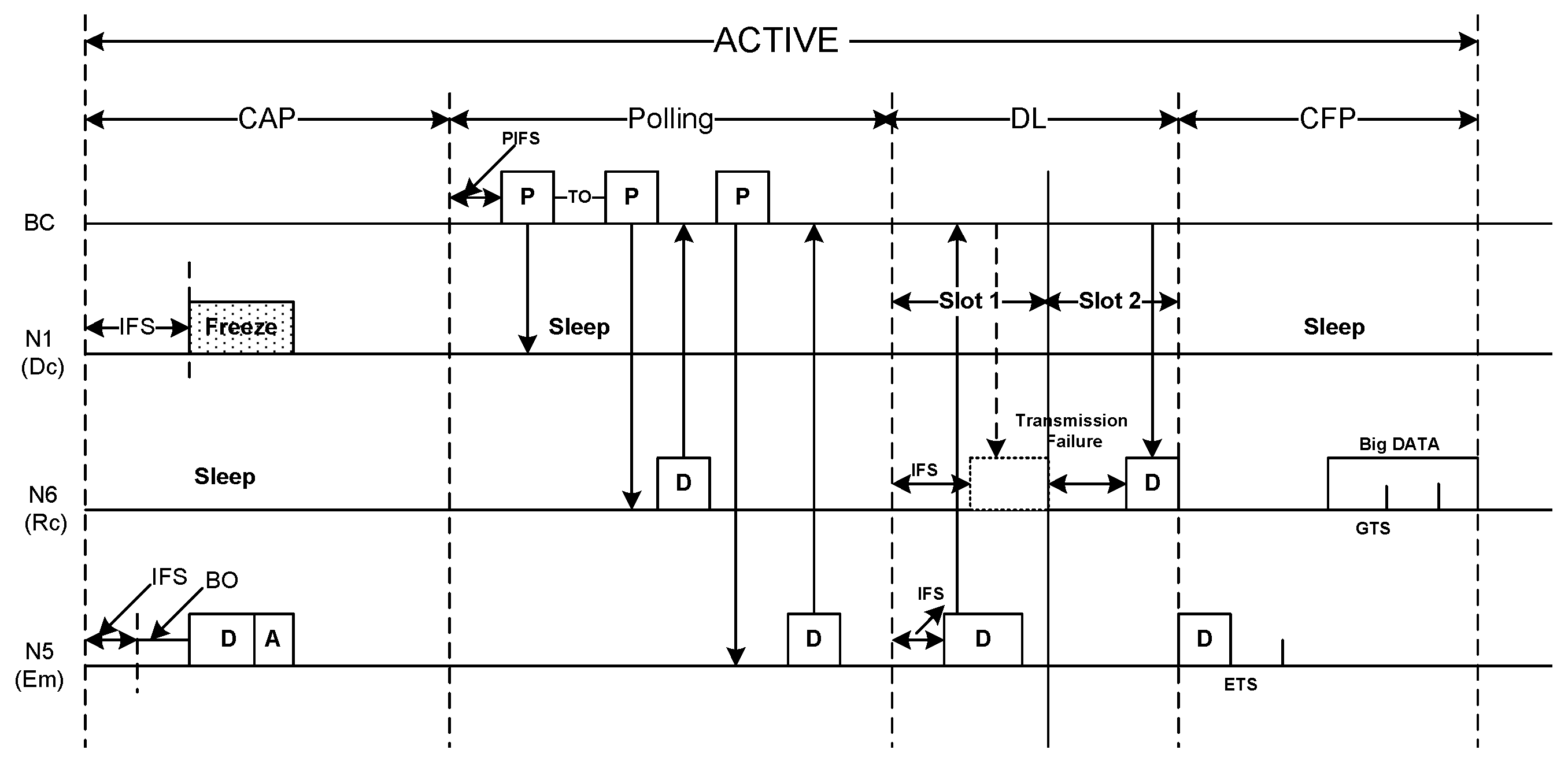
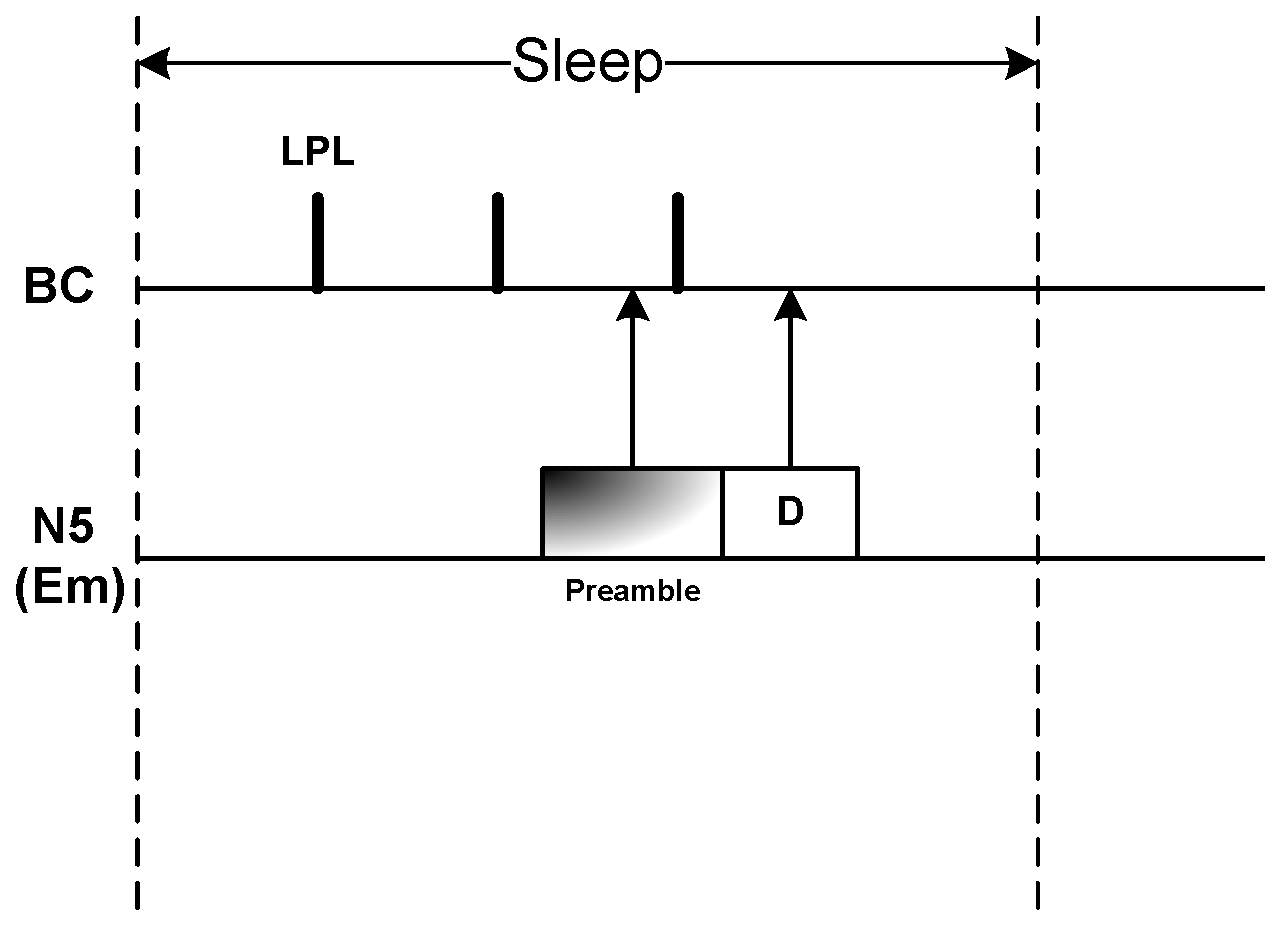







| Dr | Nr |
|---|---|
| IFS = 2 slots | IFS = 4 slots |
| = 2 slots | = 8 slots |
| = 8 slots | = 16 slots |
| Traffic Type | Sensor ID |
|---|---|
| 1,8 | |
| 3,6 | |
| 4,5 | |
| 2,7 |
| Type | Parameter | Value |
|---|---|---|
| Physical Layer | Transmission band | 2.4 GHz |
| Data Rate | 250 kbps | |
| Tx Power | 2.428 mW | |
| Rx Power | 1.814 mW | |
| Sleep Power | 0.027 mW | |
| Listening power | 1.814 mW | |
| PHY Header | 6 bytes | |
| Channel Encoding Ratio | 2 | |
| MAC Layer | Beacon length | 10 bytes |
| ACK length | 8 bytes | |
| Poll length | 7 bytes | |
| small Payload length | 7 bytes | |
| Big Payload length | 10–50 bytes | |
| 500 ms | ||
| 40 μs | ||
| GTS Slot time | 448 μs | |
| CAP | 20 ms | |
| Polling period | 15 ms | |
| DL period | 10 ms | |
| CFP | 55 ms | |
| Sleep period | 410 ms | |
| 1 ms | ||
| Long Preamble length | 950 μs | |
| Tx Range | 5 m | |
| Sensing range | 10 m | |
| Max Retry Limit | 3 | |
| Queue Size | 10 packets | |
| Thermal Rise | Relative Permittivity at 2 MHz, | 826 |
| Conductivity at 2 MHz, | 0.5476 | |
| 3600 | ||
| Blood perfusion constant, b | 2700 | |
| Discretized Time step, | 500 ms | |
| 37 °C | ||
| Current provided to sensor antenna, I | 0.1 A | |
| Mass density, | 1040 | |
| K | 0.498 | |
| Discretized Space Step, | 0.2 m | |
| Hotspot threshold, | 37.4 °C |
© 2020 by the authors. Licensee MDPI, Basel, Switzerland. This article is an open access article distributed under the terms and conditions of the Creative Commons Attribution (CC BY) license (http://creativecommons.org/licenses/by/4.0/).
Share and Cite
Monowar, M.M.; Alassafi, M.O. On the Design of Thermal-Aware Duty-Cycle MAC Protocol for IoT Healthcare. Sensors 2020, 20, 1243. https://doi.org/10.3390/s20051243
Monowar MM, Alassafi MO. On the Design of Thermal-Aware Duty-Cycle MAC Protocol for IoT Healthcare. Sensors. 2020; 20(5):1243. https://doi.org/10.3390/s20051243
Chicago/Turabian StyleMonowar, Muhammad Mostafa, and Madini O. Alassafi. 2020. "On the Design of Thermal-Aware Duty-Cycle MAC Protocol for IoT Healthcare" Sensors 20, no. 5: 1243. https://doi.org/10.3390/s20051243
APA StyleMonowar, M. M., & Alassafi, M. O. (2020). On the Design of Thermal-Aware Duty-Cycle MAC Protocol for IoT Healthcare. Sensors, 20(5), 1243. https://doi.org/10.3390/s20051243






